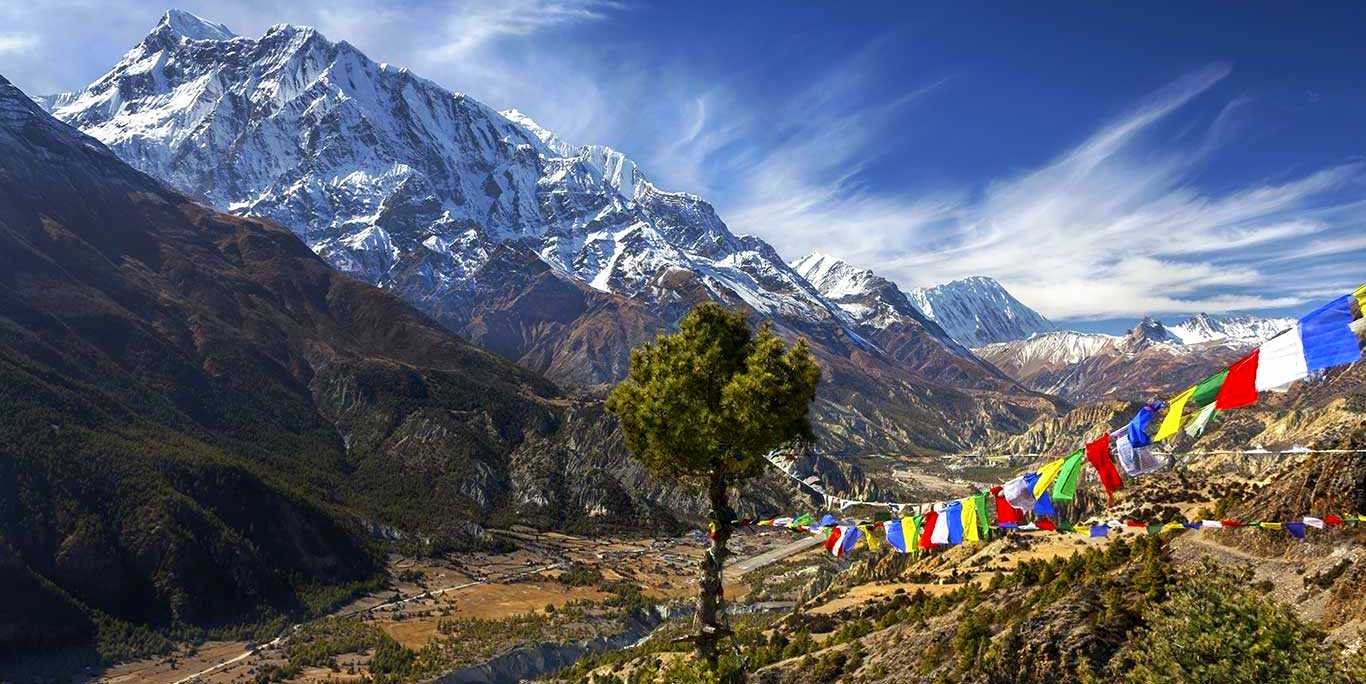Annapurna Circuit Trek
The Annapurna Circuit Trek is a world-renowned trekking route in Nepal, celebrated for its stunning diversity in landscapes and cultures. This trek circles the Annapurna massif, traversing through four different regions: Lamjung, Manang, Mustang, and Myagdi, which offer a unique blend of ethnicities and environments. The trek typically takes between 12 to 21 days to complete, depending on the starting point, itinerary pace, and side trips.
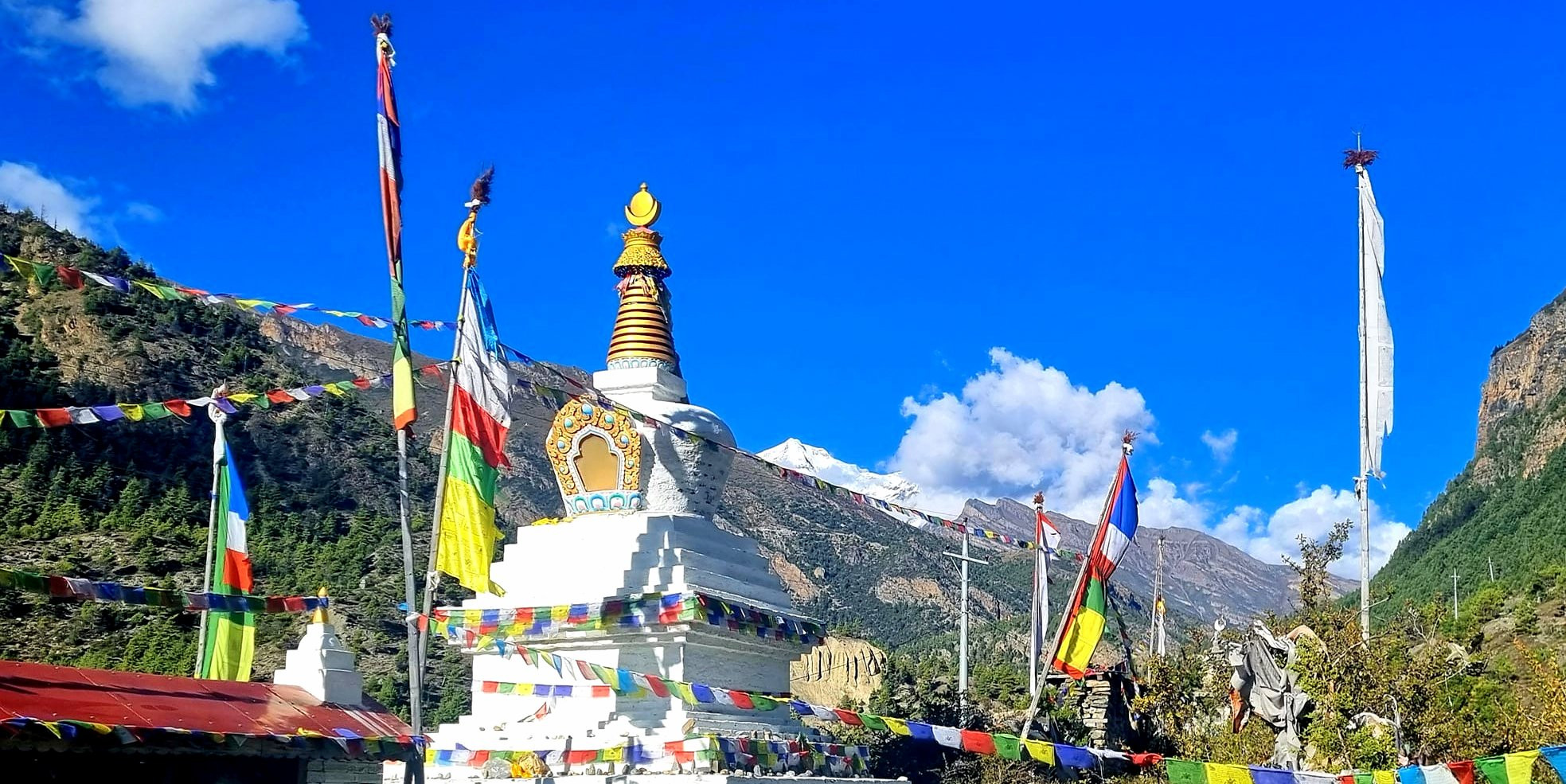
Key Highlights of the Annapurna Circuit Trek
-
Diverse Terrain: Trekkers on the Annapurna Circuit experience an incredible variety of landscapes, from lush subtropical forests and paddy fields in the lower reaches to high-altitude plateaus that offer stark, rugged mountain views.
-
Thorong La Pass: At 5,416 meters (17,769 feet), crossing Thorong La is the highest and most challenging part of the trek, offering exhilarating views and a significant sense of achievement.
-
Cultural Richness: The trek passes through various villages where trekkers can experience the daily lives and cultures of different ethnic groups, including Gurungs, Manangis, and Thakalis.
-
Manang and Mustang: These districts offer fascinating insights into Tibetan-like cultures. They feature ancient monasteries, traditional villages, and stunning landscapes.
-
Sacred Sites: The route includes important religious sites like Muktinath, a sacred place for both Hindus and Buddhists, which adds a spiritual dimension to the journey.
-
Wildlife and Flora: The diverse climates and ecosystems along the circuit support an abundance of wildlife and plants, including rhododendron forests, which bloom spectacularly in spring.
Logistics and Planning
-
Permits: For the Annapurna Circuit, trekkers need two permits: the Annapurna Conservation Area Permit (ACAP) and the Trekkers' Information Management System (TIMS) card.
-
Best Time to Trek: The best months for the Annapurna Circuit are October and November when the weather is clear and dry, and March to April, which features warmer temperatures and blooming rhododendrons.
-
Trek Difficulty: It is considered a moderate to challenging trek, mainly due to its length and the high altitude, especially at Thorong La Pass. Proper acclimatization is essential to avoid altitude sickness.
-
Accommodation: The circuit is well-developed for tourism, with a range of teahouses offering basic to comfortable lodging and meals throughout the trek.
The Annapurna Circuit Trek remains a top choice for trekkers globally, offering an unforgettable adventure that combines physical challenges with cultural enrichment and natural beauty. It's an excellent option for those seeking a comprehensive trekking experience in the Himalayas.
Annapurna Base Camp Trek
The Annapurna Base Camp Trek, also known as ABC Trek, is a highly popular and spectacular journey into the heart of the Annapurna Range in Nepal. This trek brings adventurers up close to some of the highest and most awe-inspiring mountains in the world, including Annapurna I, Annapurna South, Machapuchare (Fishtail Mountain), and Hiunchuli. The trek typically spans 7 to 12 days, depending on the chosen route and pace.
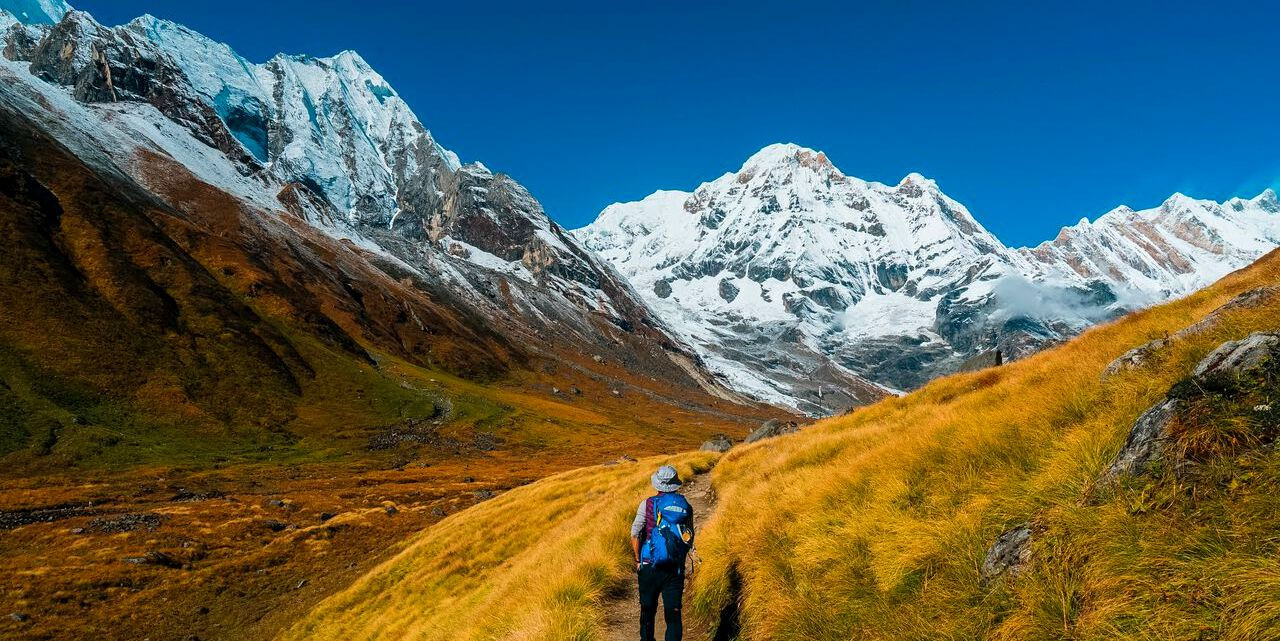
Key Highlights of the Annapurna Base Camp Trek
-
Spectacular Mountain Vistas: This trek offers unparalleled views of towering peaks surrounding the Annapurna Sanctuary, a natural amphitheater that is a highlight of the journey.
-
Diverse Landscapes: The route passes through a variety of ecosystems, from rice paddies and subtropical forests to high-altitude landscapes and glacial zones.
-
Machapuchare Base Camp: En route to Annapurna Base Camp, trekkers also stop at Machapuchare Base Camp, which provides stunning up-close views of the sacred and beautifully shaped Machapuchare peak.
-
Cultural Insight: The trek goes through the traditional villages of the Gurung and Magar communities, offering insights into the rural lifestyles and cultures of Nepal’s ethnic groups.
-
Accessibility and Duration: Being shorter than the Annapurna Circuit, this trek is more accessible to people with limited time who still want to experience the majesty of the Himalayas.
Logistics and Planning
-
Permits: Similar to other treks in the region, you’ll need the Annapurna Conservation Area Permit (ACAP) and the Trekkers' Information Management System (TIMS) card.
-
Trek Difficulty: This trek is considered moderate in difficulty. Although it does not reach the extremes of altitude seen on some Himalayan treks, the paths can be steep and the days long, especially the closer you get to the Base Camp.
- Accommodation: The trek is well-serviced by teahouses and lodges along the entire route, which offer hot meals and comfortable beds. These teahouses provide a cozy, communal atmosphere, giving trekkers a chance to interact with fellow hikers from around the world.
Challenges and Considerations
-
Altitude Sickness: While not as high as other treks, altitude sickness can still be a risk. Proper acclimatization days are recommended, especially at higher elevations near the Base Camp.
-
Weather Conditions: Weather in the Himalayas can be unpredictable. Trekkers should be prepared for sudden changes in conditions, especially if trekking outside the optimal seasons.
The Annapurna Base Camp Trek remains a favorite for those looking to experience significant Himalayan altitudes without the extended duration of treks like the Annapurna Circuit. It offers a compelling mix of natural beauty, physical challenge, and cultural immersion, making it a memorable adventure for any trekker.
Ghorepani Poon Hill Trek
The Ghorepani Poon Hill Trek is one of the most accessible and immensely popular treks in the Annapurna region of Nepal, famed for its breathtaking mountain vistas and charming cultural experiences. Often referred to as the Poon Hill Sunrise Trek, it is particularly known for the spectacular sunrise views it offers from Poon Hill over the Annapurna and Dhaulagiri massifs. This trek is ideal for those who have limited time or are looking for a relatively easy introduction to Himalayan trekking.
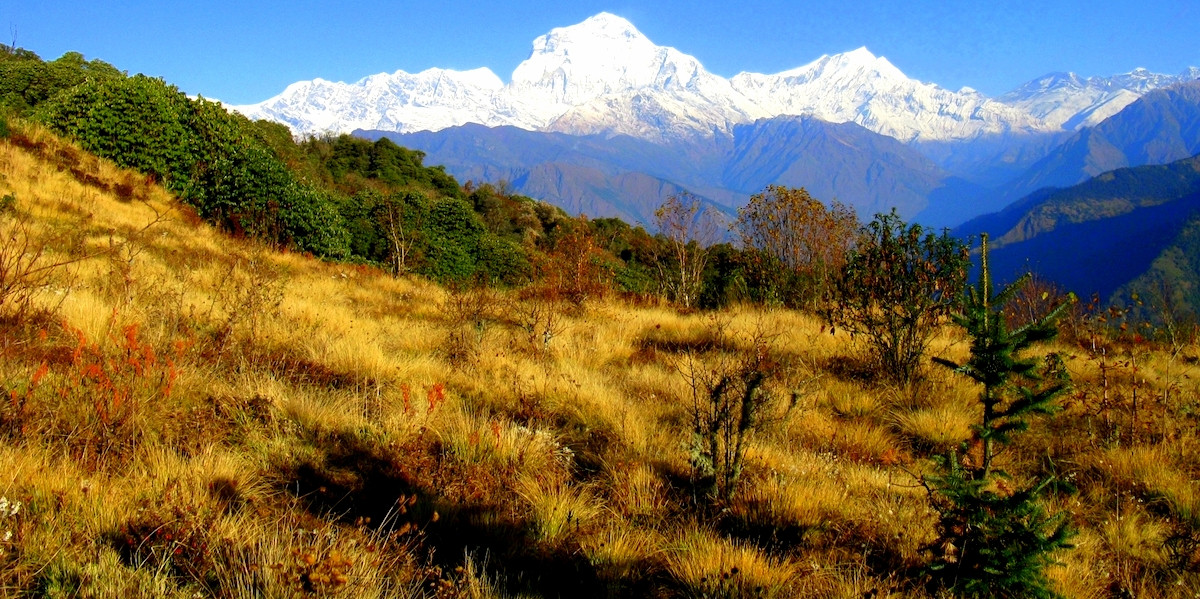
Key Highlights of the Ghorepani Poon Hill Trek
-
Poon Hill Sunrise: Climbing to the Poon Hill viewpoint (3,210 meters) early in the morning to witness the sun rising over the high Himalayas is the defining moment of the trek. The panoramic views include several high peaks such as Annapurna South, Annapurna I, Dhaulagiri, and Machapuchare (Fishtail Mountain).
-
Rhododendron Forests: The trek passes through dense forests of rhododendron, which are spectacularly vibrant when in full bloom during the spring months (March to April).
-
Cultural Richness: The trail meanders through various Gurung and Magar villages, offering trekkers a glimpse into the traditional lifestyles of these ethnic communities. This includes the opportunity to experience local hospitality in teahouses and guesthouses.
-
Accessibility and Short Duration: Typically lasting only about 4-5 days, the Ghorepani Poon Hill trek is shorter and less strenuous than other Himalayan treks, making it suitable for a wide range of ages and fitness levels.
Logistics and Planning
-
Permits: As with other treks in the region, you will need the Annapurna Conservation Area Permit (ACAP) and the Trekkers' Information Management System (TIMS) card.
-
Trek Difficulty: This trek is considered easy to moderate, involving some steep climbs but nothing too challenging if you are reasonably fit. Daily walking times average between 4 to 6 hours.
-
Accommodation: The trail is well-developed with numerous comfortable teahouses that provide good lodging and food options, ensuring a comfortable journey throughout.
Challenges and Considerations
-
Crowds: Given its popularity and accessibility, the Poon Hill trek can get crowded, especially during peak seasons. Early booking of accommodations and starting your daily trek early in the morning can help avoid the crowds.
-
Weather Conditions: Weather can still be variable, particularly outside the peak seasons of spring and autumn, so adequate preparation in terms of gear and clothing is essential.
The Ghorepani Poon Hill Trek is an excellent choice for those wanting to experience the beauty of the Nepalese Himalayas without committing to a long or particularly strenuous trek. It combines natural beauty with cultural exposure and is perfect for families, beginners, or those short on time but eager to experience the magic of the mountains.
Mardi Himal Trek
The Mardi Himal Trek is a hidden gem in the Annapurna region, offering a quieter alternative to the more crowded trails like the Annapurna Base Camp or Poon Hill treks. This trek is relatively new, having been officially opened to tourists only in 2012, but it has quickly gained popularity for its pristine landscapes and up-close views of the Annapurna range, including Machapuchare (Fishtail Mountain) and Mardi Himal itself.
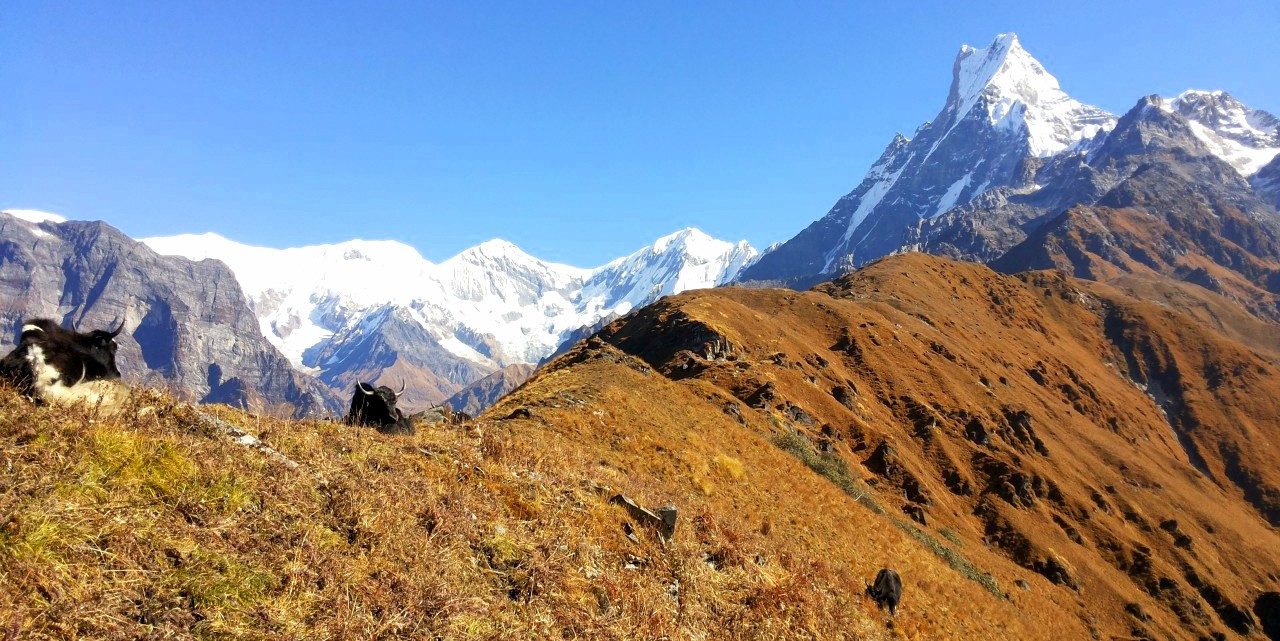
Key Highlights of the Mardi Himal Trek
-
Close-Up Mountain Views: The trek offers spectacular close-up views of Machapuchare, Annapurna South, and Hiunchuli, providing a more intimate experience with the Himalayas.
-
Off-the-Beaten-Path Experience: Less developed and less crowded than the classic treks in the region, the Mardi Himal Trek provides a sense of solitude and untouched natural beauty.
-
Varied Terrain: The path takes trekkers through lush rhododendron forests, up rocky mountain paths, and across high ridges, showcasing the ecological diversity of the Annapurna Conservation Area.
-
High Ridge Trekking: The route includes walking along a ridge that provides breathtaking panoramic views of the Himalayan peaks and valleys.
Logistics and Planning:
-
Permits: Like other treks in the Annapurna area, trekkers need an Annapurna Conservation Area Permit (ACAP) and a Trekkers' Information Management System (TIMS) card.
-
Trek Difficulty: This trek is considered moderate in difficulty. It involves some steep sections and narrow paths, particularly as you approach the upper viewpoints. The highest point of the trek is the Mardi Himal Base Camp, situated at around 4,500 meters (14,764 feet).
-
Accommodation: The trek is facilitated by several newly built teahouses along the route, offering basic but comfortable lodging and meals.
Challenges and Considerations
-
Altitude and Physical Fitness: While not as high as some other treks in Nepal, the altitude can still be challenging, and a good level of fitness is required to enjoy the trek comfortably.
-
Emerging Route: As an emerging trekking route, some parts of the Mardi Himal Trek are not as well developed as other more established trails. This can be a positive for those seeking a more rugged and authentic experience, but it also means that facilities are more basic and less frequent.
-
Weather Sensitivity: Due to its high ridges and exposed trails, the trek can be quite sensitive to weather conditions. Adequate preparation and flexibility in travel plans are essential to accommodate changes due to weather.
The Mardi Himal Trek is an excellent choice for those looking to explore a less trodden part of the Annapurna region. It offers a unique blend of solitude, natural beauty, and physical challenge, making it a rewarding journey for those willing to venture off the traditional paths.
Khopra Danda Trek
The Khopra Danda Trek, also known as the Khopra Ridge Trek, is one of the lesser-known treks in the Annapurna region, providing a remarkable off-the-beaten-path adventure. This trek is celebrated for its stunning panoramic views of the Annapurna and Dhaulagiri ranges, and for offering a more secluded and intimate experience with the natural beauty of Nepal.
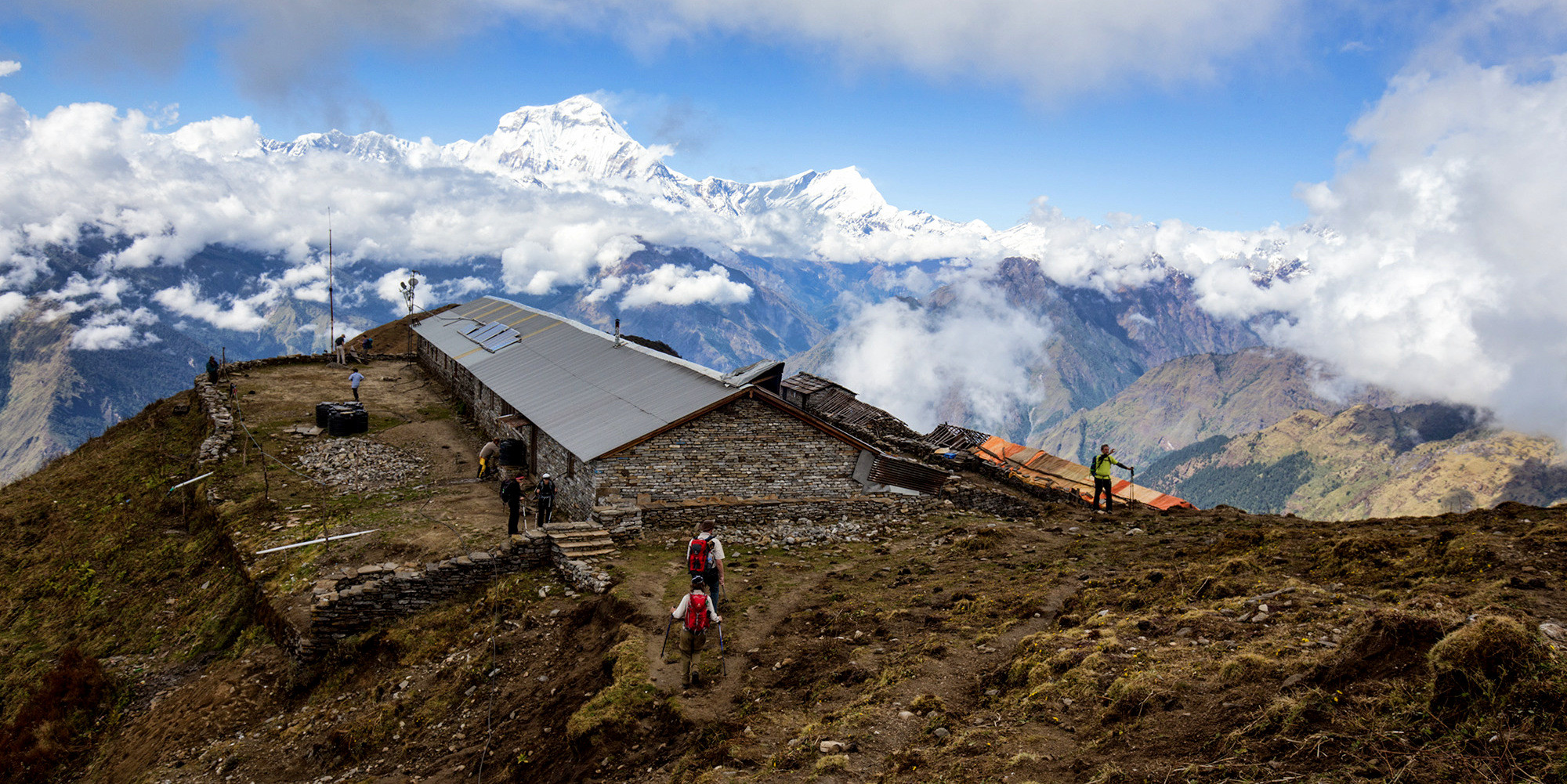
Key Highlights of the Khopra Danda Trek
-
Stunning Panoramic Views: From Khopra Ridge, trekkers enjoy breathtaking views of famous peaks such as Dhaulagiri, Annapurna South, and Nilgiri. The viewpoint at Khopra Danda is among the best in the region for panoramic mountain vistas.
-
Community-Based Trekking: This trek is unique in that it operates on a community lodge model, where local communities benefit directly from tourism. Staying in community lodges provides a more authentic and immersive experience into the local culture and lifestyle.
-
Khayer Lake: An optional but highly recommended side trek from Khopra Danda leads to Khayer Lake, a sacred high-altitude lake located at about 4,600 meters. The trek to the lake is challenging but rewarding, with spiritual significance for local communities.
-
Rich Biodiversity: The trek passes through lush rhododendron forests, alpine meadows, and high pastures, offering opportunities to see a variety of flora and fauna endemic to the region.
Logistics and Planning
-
Permits: Trekkers need an Annapurna Conservation Area Permit (ACAP) and a Trekkers' Information Management System (TIMS) card, similar to other treks in the region.
-
Trek Difficulty: The Khopra Danda Trek is considered moderate in difficulty. It involves some steep climbs and high-altitude trekking, especially if including the side trek to Khayer Lake.
-
Accommodation: The community lodges along the Khopra Danda Trek offer basic but comfortable facilities, providing a closer connection to the local community and a chance to support local entrepreneurship.
Challenges and Considerations
-
Altitude: Reaching up to 3,660 meters at Khopra Ridge and higher at Khayer Lake, altitude can be a challenge, requiring proper acclimatization to prevent altitude sickness.
-
Remote Location: The trek's remote nature means that some sections have fewer facilities compared to more popular routes. This requires good planning and preparation, particularly in terms of food and water supplies, as well as emergency communication options.
-
Weather Conditions: Weather can be a significant factor, with sudden changes that can affect trekking conditions, especially during the shoulder seasons.
The Khopra Danda Trek is ideal for those seeking a quieter trekking route that not only challenges the body but also enriches the soul through close encounters with nature and local Nepalese culture. It's a perfect choice for trekkers looking to escape the more crowded trails and experience something truly special in the Annapurna region.
Tips for Top 5 Treks in the Annapurna Region
Trekking in the Annapurna Region of Nepal is a breathtaking experience, filled with stunning landscapes and rich cultural encounters. Here are essential tips for making the most of the top 5 treks in the Annapurna Region:
Prepare Physically
-
Condition Your Body: Regardless of the trek's difficulty, it’s important to prepare physically. Regular cardio exercises like running, cycling, and hiking can help, as can strength training for legs, back, and core.
-
Acclimate Properly: Spend a few days at higher elevations before starting your trek if possible, and follow a slow ascent profile to reduce the risk of altitude sickness.
Pack Smart
-
Layered Clothing: Weather in the mountains can change rapidly. Pack breathable, moisture-wicking base layers, insulating layers, and a waterproof and windproof jacket.
-
Essential Gear: Include a sturdy pair of hiking boots, a comfortable backpack, sleeping bag suitable for cold temperatures (if staying in basic teahouses), and a trekking pole for support.
Understand the Permits Required
- ACAP and TIMS: For any trek in the Annapurna Region, you’ll need an Annapurna Conservation Area Permit (ACAP) and a Trekkers' Information Management System (TIMS) card. Obtain these in advance in Kathmandu or Pokhara.
Choose the Right Season
- Best Trekking Seasons: The best times for trekking in Annapurna are during the post-monsoon season (late September to November) when the skies are clearest, and pre-monsoon (March to May) when temperatures are warmer and the trails less crowded. Rhododendron forests are also in full bloom during the spring.
Stay Safe
-
Hire a Guide or Porter: Especially if you are new to trekking in the Himalayas, hiring a guide can enhance your experience and provide added safety. Porters can help carry your load, allowing you to focus on the hike.
-
Travel Insurance: Make sure you have travel insurance that covers high-altitude trekking and medical evacuation.
Respect Local Customs
-
Cultural Sensitivity: The Annapurna region is home to diverse ethnic groups. Be respectful of local customs and traditions, dress modestly, and ask permission before taking photographs of people.
-
Environmental Responsibility: Carry out all your trash, use water sparingly (it's a precious resource in many villages), and stay on established trails to minimize your impact on the natural environment.
Stay Informed and Flexible
-
Weather and Trail Conditions: Check the weather forecast and trail conditions before and during your trek. Be prepared to alter your plans if conditions deteriorate.
-
Local Developments: Road construction and new teahouse developments can change trail conditions and available accommodations. Check recent reviews and talk to locals for the latest information.
Manage Health
- Prevent Altitude Sickness: Monitor for symptoms of altitude sickness, which can become serious if ignored. Ascend gradually, and descend to a lower altitude if symptoms increase.
Stay Hydrated and Energized: Drink plenty of water and eat sufficient calories. Trekking at high altitudes increases your hydration needs and calorie expenditure.
By following these tips, you'll be well-prepared to tackle the trails of Annapurna safely and enjoyably, making the most of this incredible trekking adventure.
Ideal Time for Top 5 Treks in the Annapurna Region
Trekking in the Annapurna Region offers different experiences depending on the season. Here's a detailed look at what each season offers for trekkers looking to explore this beautiful part of Nepal:
Spring (March to May)
-
Weather: Spring is one of the most popular times to trek in the Annapurna Region. The weather is generally warm and stable with clear skies, especially in April and May.
-
Scenery: This season witnesses the spectacular bloom of rhododendrons and other wildflowers, particularly evident on trails like the Ghorepani Poon Hill Trek. The forests and hillsides burst into a riot of colors, making the hikes visually stunning.
-
Advantages: Spring offers some of the best mountain views, with minimal cloud cover later in the season. The temperatures are also comfortable for trekking.
-
Considerations: Trails can be crowded, as this is a peak trekking season.
Summer/Monsoon (June to August)
-
Weather: The monsoon season brings heavy rains, especially in July and August, which can result in slippery trails and leeches. However, mornings often start clear with cloud build-ups occurring in the afternoon.
-
Scenery: The landscape is lush and green, with waterfalls at their full might and rivers swollen with rainwater.
-
Advantages: The trails are less crowded, and the rain washes the dust away, making the air clean and fresh. This is also a great time for keen botanists as the flora is in full bloom.
-
Considerations: Views of the mountains can be obstructed by clouds, and trekking conditions can be challenging due to the rain. Good waterproof gear is essential.
Autumn (September to November)
-
Weather: Autumn is considered the best season for trekking in the Annapurna Region. The post-monsoon climate means the sky is usually clear and the mountain views are spectacular.
-
Scenery: The landscape is still lush at the beginning of the season, and as the months progress, the views become clearer.
-
Advantages: This season offers some of the most stable and clear weather, ideal for photography and high-altitude treks like the Annapurna Circuit or Annapurna Base Camp Trek.
-
Considerations: Like spring, autumn is a peak trekking season, so the trails can be quite busy, and accommodation in popular areas may need to be booked in advance.
Winter (December to February)
-
Weather: Winter in the Annapurna Region is cold, especially at higher altitudes, with temperatures often dropping below freezing.
-
Scenery: The mountains are covered with snow, offering breathtaking winter landscapes. Days are usually sunny and clear.
-
Advantages: Trails are less crowded, and the mountain views are among the clearest and most stunning during this season. It's a great time for those who prefer a quieter trekking experience.
-
Considerations: Nighttime temperatures can be extremely cold, and some higher altitude passes and teahouses might be closed due to snow. Proper winter gear and preparation for cold weather are essential.
Each season in the Annapurna Region has its charms and challenges, making it a year-round trekking destination. Choosing the right season depends on what you want to experience and how well you are prepared for the conditions you'll encounter.
The Annapurna Region of Nepal offers a diverse array of trekking experiences that cater to all types of adventurers. From the challenging Annapurna Circuit to the family-friendly Ghorepani Poon Hill Trek, each route provides a unique blend of breathtaking landscapes, cultural insights, and personal challenges. Whether you prefer the solitude of Mardi Himal, the cultural depths of Annapurna Base Camp, or the community-focused Khopra Danda Trek, there's a trek here to suit your desires. The success of your adventure in Annapurna hinges on careful planning, respect for local customs, and preparedness for high-altitude trekking. By choosing the right season and embracing the journey with an open spirit, trekking in the Annapurna Region can offer transformative experiences and enduring memories.
FAQs for Top 5 Treks in the Annapurna Region
Q: What is the best time to trek in the Annapurna Region?
A: The optimal trekking seasons in the Annapurna Region are during the spring (March to May) and autumn (October to November). These periods feature clear skies, stable weather, and the best visibility of the mountains.
Q: Do I need a guide for trekking in the Annapurna Region?
A: While not mandatory, it's highly recommended to hire a guide, particularly for novice trekkers. Guides can enhance your safety, provide insights into the local culture and environment, and help in case of emergencies.
Q: What permits are required for trekking in the Annapurna Region?
A: All trekkers are required to obtain an Annapurna Conservation Area Permit (ACAP) and a Trekkers' Information Management System (TIMS) card.
Q: What should I pack for a trek in the Annapurna Region?
A: Essential items include sturdy hiking boots, a durable backpack, water purification tools, layered clothing suitable for variable temperatures, a first aid kit, a map, and a sleeping bag for cold nights.
Q: What are the risks of trekking in the Annapurna Region?
A: Key risks include altitude sickness, sudden weather changes, and potential trail injuries. Proper preparation and awareness can mitigate these risks.
Q: Can I trek independently in the Annapurna Region?
A: Yes, particularly on popular routes like the Ghorepani Poon Hill Trek. For remote treks such as Mardi Himal and Khopra Danda, having a guide is advisable for safety reasons.
Q: What are the accommodation options like on these treks?
A: Accommodations range from basic teahouses to more comfortable lodges. Availability and comfort level increase with proximity to the more frequented trails.
Q: How do I deal with altitude sickness?
A: To prevent altitude sickness, acclimatize gradually, stay hydrated, ascend slowly, and avoid alcohol. Descend immediately to a lower altitude if symptoms appear.
Q: Are there any cultural tips I should know about before trekking in the Annapurna Region?
A: Dress modestly, ask permission before taking photos, respect local customs and traditions, and show consideration at sacred sites.
For the Nepal tour, please click here.
If you are looking for different kinds of Nepal Tours or Trekking Packages, feel free to contact us.
